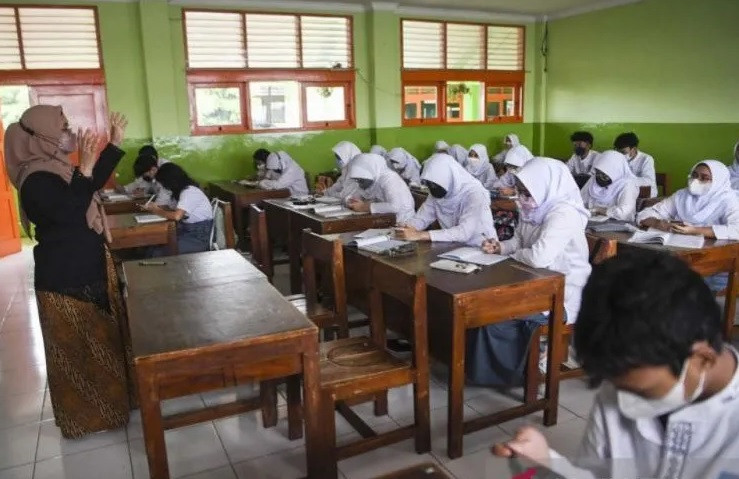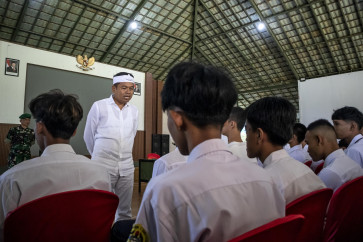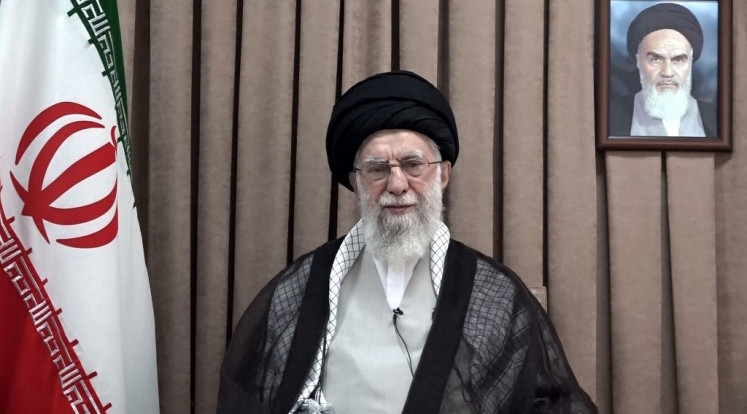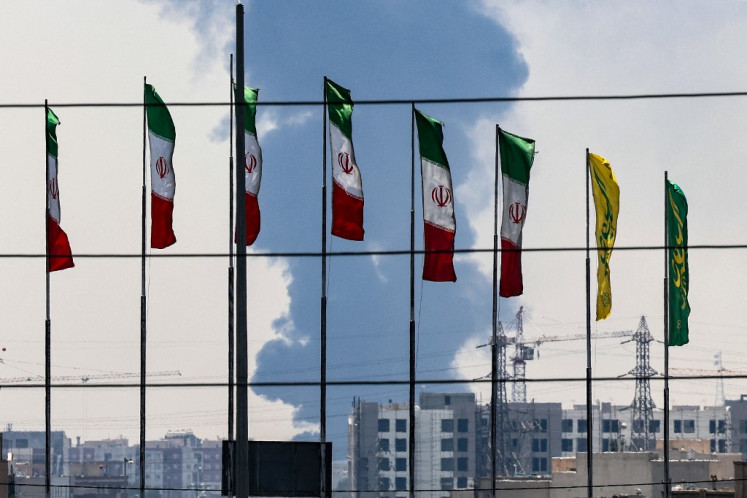Popular Reads
Top Results
Can't find what you're looking for?
View all search resultsPopular Reads
Top Results
Can't find what you're looking for?
View all search resultsPower relations and the hijab discipline
There must be a generally accepted explanation about the obligation to wear the hijab, like the obligation to wear red, blue and gray uniforms for elementary, junior high and high school students.
Change text size
Gift Premium Articles
to Anyone

W
hat lessons can we learn from the recent shaving or cutting of the hair of 19 female students at a state junior high school in Lamongan, East Java? The punishment for “violating” the rules of wearing the hijab in its many forms is saddening but will recur because the solutions offered fail to address the root of the problem.
We recall a case that later went viral on social media about a non-Muslim female student at a state vocational school in Padang, West Sumatra, in 2021. She felt she was forced to wear the hijab as a religious garment. This incident ended with a statement from the school that wearing the hijab was not mandatory, thus giving the student the freedom to choose. However, she and her family were bullied by the community who believed the school's Muslim dress code policy was correct.
Therefore, the hair-cutting case should be viewed in a broader context to understand what actually happened and how to prevent it recurring in the future. Using the "power relations" theory of the French philosopher Michel Foucault, we can see power relations operating in this case. Inequality clearly marks the relation between a teacher and students, between the discipline-enforcing teacher and the prone-to-discipline students, between the regional educational institution and the school, and between the school and the victims’ parents.
From a feminist perspective, this act of forcing students to wear the hijab by punishing violators is an elaboration of the concept of power relations, both political and gender relations.
These two power relations are a simplification of the portrayal of relations that view the aspects of politics and social gender as the most dominant elements that form the basis of unequal relationships between perpetrators and victims. In this concept, power relations are closely related to the power over knowledge, which has an effect on oppression.
Beyond Foucault's power relations concept, the hair-cutting incident is a perfect example of the operation of power relations that are almost uncontrollable due to the power over the issuance of disciplinary regulations, which are stipulated unilaterally based on ethical norms derived from a polarizing religious perspective.
This happens when those in power (teachers) not only feel controlled by their superiors (school principals, school committees, local technical implementation units, the education ministry), but also feel that they are entrusted by God to enforce religious commands, in this case the obligation to cover aurat (the female form).
However, their attitude may very well not be driven solely by their personal views, but rather because of the ambiguity of the rules. The rules regarding the hijab usually refer to Education and Culture Minsitry Regulation No. 59/2014 concerning the 2013 National Curriculum, which has never been annulled. The regulation deals with dress code in point 1.4: "Dressing according to Islamic sharia in daily life". This vague statement actually leads to an interpretation of the obligation to wear the hijab according to the wishes of those in power, in this case, the school or teacher.
Therefore, many have defended the teacher's disciplinary actions. They insist that the teacher was disciplining the students' morals according to the commands of religion (Islam).
However, the solutions to this incident do not actually touch on the core issue of who has the right to determine someone's morality in wearing the hijab. The school and the relevant government agency only doused the flame but not the source of the blaze. They visited the students' parents to explain the situation, namely the enforcement of hijab discipline, which they admitted was overzealous.
It can be imagined that in such an unequal power relationship, the students' parents must accept the explanation that the action was actually intended for the positive purpose of discipline. By apologizing and suspending the teacher concerned, the problem is considered settled.
There are at least two fundamental issues in this incident. First, it is related to the classic question of whether the hijab is mandatory in schools, including public schools where, like at Padang, not all students are Muslim or not everybody believes that wearing the hijab is a religious obligation.
Or, from another angle, whether the hijab is part of the school uniform that is not connected to a certain belief. If the hijab is part of the school uniform and is mandatory, then there must be a rational philosophical basis for that policy that is free from belief-based reasons.
There must be a generally accepted explanation about the obligation to wear the hijab, like the obligation to wear red, blue and gray uniforms for elementary, junior high and high school students, respectively. The consequence of this would be that wearing the hijab should be mandatory for all female students throughout Indonesia, regardless of their religion or beliefs.
Conversely, if the obligation is related to religious belief, then it cannot be made the basis for disciplinary action. Thus, wearing the hijab should be considered a free choice for students. This also means that the use of power in the relations between teachers and students, school institutions, and the community to condition the enforcement of wearing the hijab is unacceptable.
On the contrary, human rights activists have reported students receiving failing grades simply because they refused to wear the hijab and, as in the hair-cutting case, students have received punishments.
The second issue, which is more complex, is the extent to which an individual or institution feels they have the mandate to control women's bodies and sexuality using divisive and subjective standards.
What basis is used in this enforcement, and who should be responsible? At what point does this enforcement become the responsibility of the school, and what part is the responsibility of the family and the community?
Such questions stem from the long-standing debate over the separation between matters of subjective belief and universal and rational public affairs in relations in public spaces, such as schools.
Another aspect of Foucault's theory of power relations is the issue of knowledge as a source of power. In teacher-student power relations, power is stacked in layers, the power that the teacher possesses. The problem is this power aspect is not openly and objectively regulated through school regulations or laws.
For instance, who gets to control teachers’ power over assessing their students' behavior, intelligence and obedience, the power to give marks/grades and the power over understanding of belief?
Beyond Foucault's view, which proves that "knowledge" always has a power effect, in the case of enforcing the wearing of the hijab, it is clearly shown that belief/religion is the source of the teacher’s power, which is not open to debate. In such a situation, it is quite difficult for the teacher to admit mistakes in the punishment as she feels she has the role of “morality police” to enforce the commands of her God.
***
The writer is a gender equality, disability and social inclusion (GEDSI) specialist and senior researcher at Puan Amal Hayati. The views expressed are her own.









